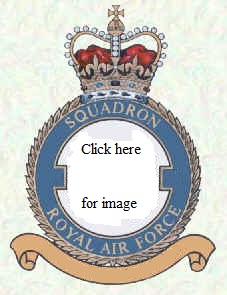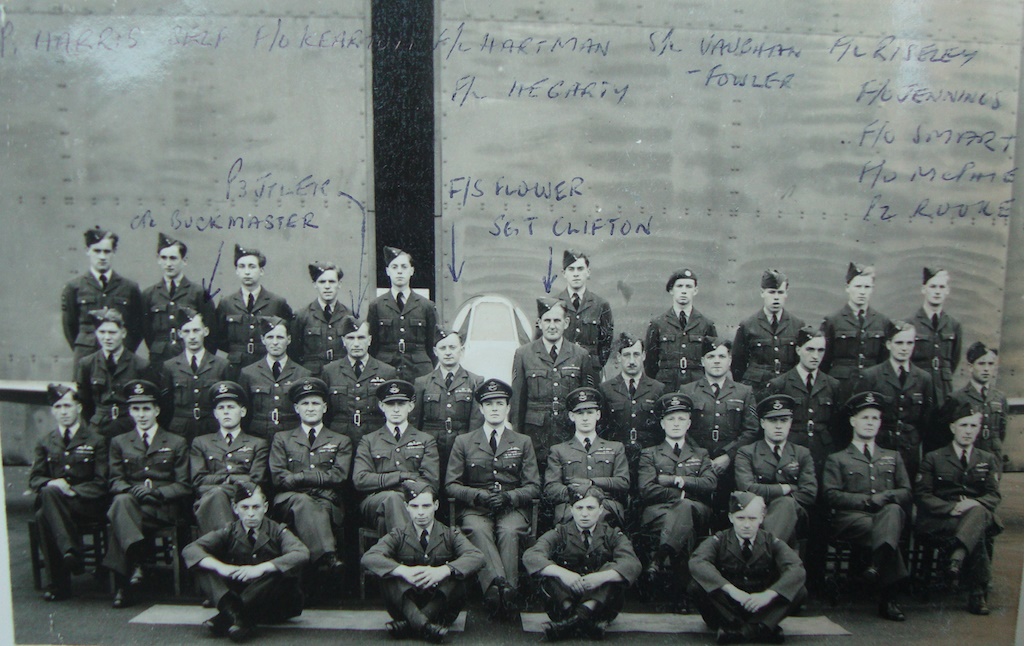Air
of Authority - A History of RAF Organisation
No 246 - 250 Squadron Histories
No 246 Squadron
No Badge Authorised |
Formed in August 1918 from No's 402, 403, 451 and 495 Flts at Seaton Carew,
it was equipped Short 184 and Sopwith Baby seaplanes as well as FE2b and
Kangaroo landplanes, the only RAF unit to operate the latter. These were
used for anti-submarine patrols along the Durham coast, disbanding in either
March or May 1919. It reformed at Bowmere as a Sunderland squadron on 1
September 1941, beginning operations in December, but on 30 April 1943 it was
disbanded, its aircraft being passed onto Nos 228, 330 and 422 Squadrons. A
new 246 Squadron was formed on 11 October 1944 at Lyneham as a Liberator
transport unit and eight days later it began flying long distance routes to the
Middle and Far East. From November 1944, it received some Halifaxes and in
December it also received Yorks, which were initially used for VIP work.
From April to July 1945, it operated a few Skymasters, but these were
transferred to No 232 Squadron, leaving it equipped with Liberators and Yorks,
the Halifaxes having left in February 1945. In November 1945 the
Liberators left and the squadron continued to operate the Yorks on routes to the
middle East and India until being disbanded when it was merged with No 511
Squadron on 15 October 1946. |
Squadron Codes used: -
| MP |
Allocated Apr 1939 - Sep 1939 |
| VU |
Dec
1944 - Oct 1946 |
[Aircraft & Markings |
Commanding Officers]
No 247
(China-British) Squadron
 |
Formed
on 20 August from No's 336, 337 and 338 Flts at Felixstowe, equipped with
Felixstowe F2As, which were used for anti-submarine patrols over the North Sea.
It disbanded on 22 January 1919. The only squadron to be equipped
with Gladiators throughout the Battle of Britain, having been formed on 21
August 1940, when the Fighter Flight at Sumburgh having moved south to Roborough,
on 1 July 1940, for defensive duties in the South-West of England and
particularly around Plymouth was raised to squadron status. Hurricanes
began to arrive in December but it was February 1941, before the last Gladiator
was retired and these were flown on convoy patrols and both day and night
defensive duties until September 1942. In that month it began to use its
Hurricanes on night intruder operations over France. In January
1943, it received its first Typhoon and by the following month was fully
equipped with the new type. In June it joined the newly formed 2nd
Tactical Air Force and began attacks against enemy airfields, lines of
communications and other targets in preparation for the forthcoming invasion.
Having supported the actual landings on 6 June 1944, the squadron moved to
France two weeks later and continued flying armed reconnaissance operations in
support of the advancing Allied armies through France, Belgium, Holland and into
Germany.
In August 1945 the squadron returned to Britain and converted to
Tempest IIs, but in June 1946, it was moved to Odiham, where it became the first
unit to receive the De Havilland Vampire jet fighter. These remained its
equipment , being progressively upgrade to the F Mk 3 in 1948 and the FB Mk 5 in
1949, until May 1951, when it began to re-equip with Meteors. The F Mk 8
variant was operated until June 1955, when it received Hunters and these were
used until the squadron disbanded on 31 December 1957. The squadron
reformed once more on 1 July 1960 as a Bloodhound surface-to-air missile unit at
Carnaby. Here it tasked with the protection of the the three Thor IRBM
sites in the area at Carnaby, Driffield and Catfoss. It disbanded shortly
after the three Thor units on 31 December 1963. |
Squadron Codes used: -
| HP |
Allocated Apr 1939 - Sep 1939 |
| HP
|
Aug 1940 - 1942 |
| ZY |
1942 - Dec 1949 |
 |
| No 247 Squadron - September 1949
Photo courtesy - Russ Gray |
[Aircraft & Markings |
Commanding Officers]
No 248
Squadron
 |
Formed
in August 1918 from No's 404, 405 and 453 Flights at
Hornsea Mere, it operated Short 184s and Sopwith Babys on anti-submarines
patrols along the East Yorkshire coast, disbanding on 6 March 1919.
The squadron reformed at Hendon at Hendon on 30 October 1939 as a Blenheim night
fighter unit, but it was a December before any aircraft were received.
However at that time the resources for successful night fighting (airborne
radar) were in very short supply and as a result it was transferred to Coastal
Command in February 1940. Initially based at North Coates it moved to
Thorney Island in April and Gosport a week later. In May a move to
Scotland brought it back to Fighter Command for patrols over the North Sea, but
in June it was again transferred to Coastal Command. Still based
in Scotland, it now began anti-shipping attacks along the Norwegian coast as
well as escort patrols and reconnaissance missions. In June 1941 a move to
Bircham Newton occurred and a month later its Blenheims were replaced by
Beaufighters. For three months at the end of the year it operated a
detachment at in Cornwall for similar operations over the Channel and Western
Approaches. It continued in its anti-shipping role from Bircham Newton
until February 1942, when it returned to Dyce in Scotland. Here, and from
Sumburgh from May, it carried
out long range patrols over the North Sea, but in August it was sent to Malta,
where it conducted similar operations over the Mediterranean. In
September 1942 it left its aircraft in Malta and returned to Dyce and then to
Talbenny
in Pembrokeshire, where it collected new aircraft and resumed
operations.
In December 1943 the Beaufighters were replaced by Mosquito VIs and its
main task now was fighter reconnaissance over the Channel and along the French
coast in preparation for Operation Overlord,
and from January 1944 it
operated Mosquito XVIIIs, equipped with a Molins 6-pdr gun in the nose, moving
to Portreath in February. Following the invasion, the squadron was
moved to Banff in Scotland to join the Banff Strike Wing. It operated as
part of this wing until the end of war. after which it moved to Chivenor in
July, Ballykelly in December but returned to Chivenor the same month. Its
final move was to Thorney Island in May 1946, where it was disbanded by being renumbered
No 36 Squadron on 1 October 1946. |
Squadron Codes used: -
| QK |
Allocated Apr 1939 - Sep 1939 |
| WR
|
Oct 1939 - Oct 1943 |
| DM |
Oct 1943 - 1945 |
[Aircraft & Markings |
Commanding Officers]
Enquiries for this squadron can be sent to: - 235 Squadron
Registrar, 71 Wantage Road, Reading, Berkshire, RG30 2SN Tel: 01189 57 15 32
(eve) andy.bird235ATntlworld.com (change AT to @)
No 249
(Gold Coast) Squadron
 |
Formed on 18 August 1918 from No's 400, 401, 419 and 450 Flights at Dundee, its
Short 184 and Sopwith Baby seaplanes provided anti-submarine patrols along the
East Coast of Scotland. It disbanded on 8 October 1919. The squadron reformed as a fighter unit on 16 May 1940 at Church Fenton.
It was equipped with Spitfires for the first month but these were changed to
Hurricanes in June. In August it moved south to Boscombe Down and on the
16th of the month Flight Lieutenant J B Nicholson, one of the flight commanders,
became the only Fighter Command pilot to be awarded the Victoria Cross during
World War Two, when he continued to attack and destroy a Bf110 despite his
aircraft being on fire from which he suffered severe burns.
With the Battle of Britain over, it began offensive operations
over France in December from North Weald, to where it had moved in September,
and continued these until May 1941, when it moved to Malta. It remained a
part of Malta's air defences throughout the Axis onslaught against the island,
re-equipping with Spitfires in February 1942. From November of that year
it moved over to the offensive, when it began attacks against targets in Sicily.
The squadron left Malta for Italy in October 1943 and began operations over the
Balkans. Mustangs replaced the Spitfires in September 1944 and in April
1945 it moved to Yugoslavia and then back to northern Italy in May, disbanding
at Brindisi on 16 August 1945. Just over two months later on 23
October 1945, the squadron was reformed when No 500 Squadron at Eastleigh in
Kenya was renumbered. Initially equipped with Baltimores, these were
replaced by Mosquitoes in March 1946, which it used to conduct survey flights of
the region. Once completed the squadron moved Habbaniya in Iraq in June,
where it re-equipped with Tempest Vs and VIs in December, at the same becoming a
fighter unit. In April 1949, it moved to Egypt receiving Vampires in the
following February, remaining there until June 1954, when it moved to Jordan.
It operated from Amman for the next two and a half years before moving to
Akrotiri in Cyprus in January 1957. In September it re-equipped with
Canberras, operating various marks of this aircraft until being disbanded on 24
February 1969. |
| Standards |
Battle
Honours* |
| Award
of Standard
originally announced on 5 Oct 1965, effective from 1 Apr 1965 but presented:-
?
|
Home
Waters, 1918: Battle of Britain, 1940: Home Defence:
Fortress Europe, 1941: Malta,
1941-42: Mediterranean, 1942-43: North Africa, 1942: Sicily:
Italy, 1943-45: South-East Europe, 1943-45: |
Squadron Codes used: -
| VY |
Allocated Apr 1939 - Sep 1939 |
|
GN |
May 1940 - May 1941, Jun 1943 - Sep 1944, Oct 1945 - Mar 1950 |
| T |
Mar 1942 - Jun 1943 |
[Aircraft & Markings |
Commanding Officers]
No 249 Squadron
Association: - Honorary
Secretary: Mr Tommy Cullen, 12 Bywell Avenue, South Shields, Tyne and Wear,
NE34 6RP, Tel: 01914550229, Email:
tommycullen@virginmedia.com
No 250
(Sudan) Squadron
.
 |
Formed
1 May 1918 from No's 494, 500, 501 and 502 Flights at Padstow with DH6 and DH9
aircraft, which it used for anti-submarine patrols along the Bristol Channel.
It disbanded on 15 May 1919.
The squadron reformed on 1 April
1941 when 'K' Flight at Aqir was raised to squadron status. It was
equipped with Tomahawks, which it used on defensive duties in Palestine with a
detachment operating over Syria until June when the squadron moved to the
Western Desert. A return to defensive duties, this in Egypt came in
February 1942 and in April, it converted to Kittyhawks, which it took back on
operations in the Western Desert the same month. Operating in the
fighter-bomber role it continued to provide support to the 8th Army, up to and
during the Battle of El Alamein after which it moved forward through Egypt, and
Libya until the end of North African campaign. From July 1943, the
squadron was operating from Malta against targets in Sicily moving there after
the invasion. It now began operations against Italian targets and in
September moved over to the Italian mainland. It continued to operate in
the fighter-bomber role for the rest of the war and when No 260 Squadron was
disbanded in August 1945, No 250 took over its Mustangs. These were
operated until the squadron disbanded on 2 January 1947 at Treviso. |
Squadron Codes used: -
| YE |
Allocated Apr 1939 - Sep 1939 |
| LD |
Apr 1941 - Dec 1946 |
[Aircraft & Markings |
Commanding Officers]
Squadron badge image on this page is courtesy of Steve
Clements
© Crown Copyright is reproduced with the permission of the Directorate of
Intellectual Property Rights
This page was last updated on
17/03/25©
 Organisational Index
[Top of
Page]
Sqns 251 - 255
Organisational Index
[Top of
Page]
Sqns 251 - 255


![]() Organisational Index
Organisational Index ![]()